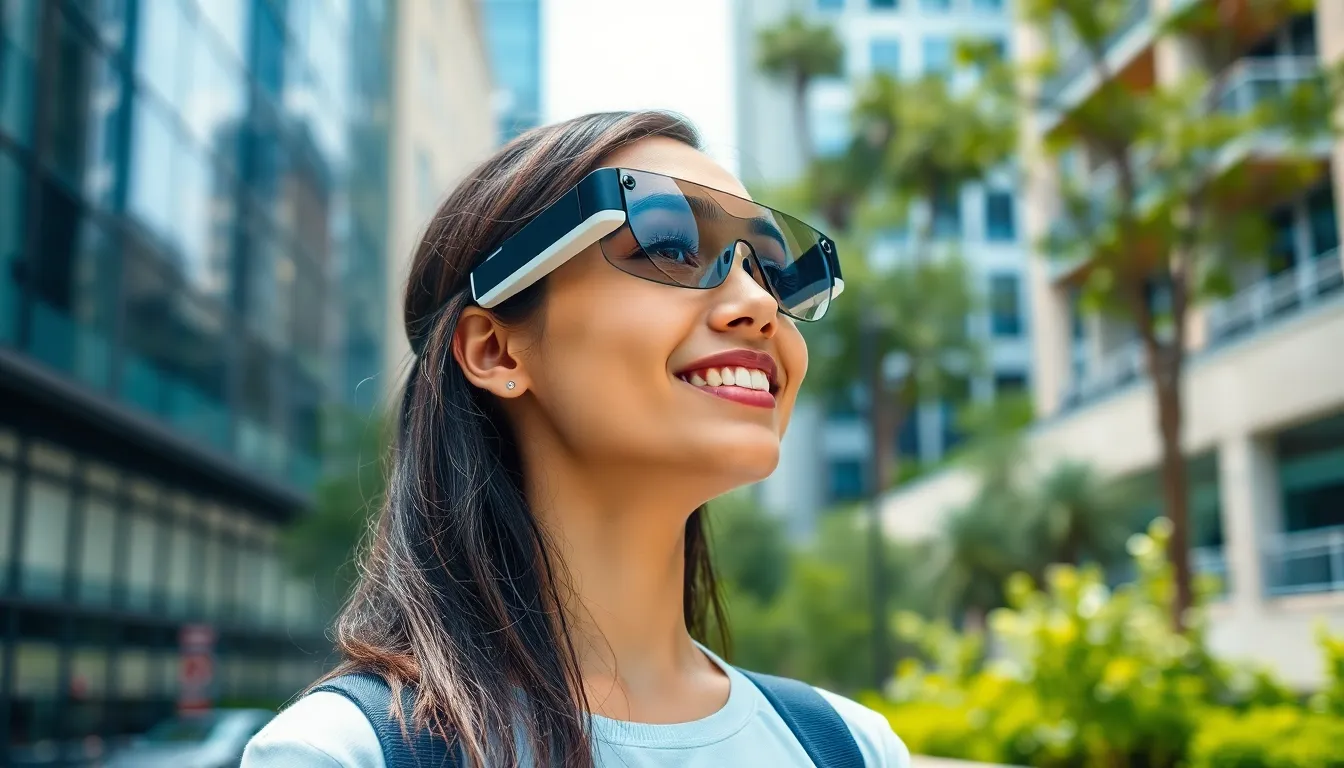In a world where technology seamlessly blends with daily life, interactive smart glasses are revolutionizing the way people interact with their surroundings. These innovative devices offer more than just a stylish accessory; they provide a gateway to augmented reality experiences, hands-free communication, and real-time information access. As they become more sophisticated, the potential applications in various fields—from healthcare to entertainment—are becoming increasingly apparent.
With features like voice commands, gesture recognition, and immersive displays, smart glasses are changing how users engage with digital content. Imagine receiving navigation prompts while cycling or accessing vital data during a surgery, all without breaking concentration. As this technology continues to evolve, it promises to enhance productivity and enrich everyday experiences, making it an exciting area to explore.
Table of Contents
ToggleOverview of Interactive Smart Glasses
Interactive smart glasses represent a cutting-edge fusion of wearable technology and augmented reality. These devices integrate digital interfaces directly into the user’s field of vision, facilitating advanced interactions with the environment. Users can access notifications, navigation prompts, and multimedia content through intuitive displays.
Features of interactive smart glasses include:
- Augmented Reality: Displays digital information overlayed on the real world, enhancing user experience in activities like gaming or navigation.
- Voice Commands: Enables hands-free operation for both simple tasks and complex interactions, promoting safety and convenience.
- Gesture Recognition: Identifies user movements to control functions, making it easy to engage with applications without physical inputs.
- Real-time Data Access: Connects to the internet to provide live updates, from stock prices to weather forecasts, directly in users’ field of view.
Applications span multiple sectors, including:
- Healthcare: Surgeons utilize smart glasses for live patient data and surgical overlays, improving precision during operations.
- Entertainment: Users experience immersive gaming or interactive storytelling, blending digital elements with reality.
- Manufacturing: Workers receive on-site instructions and diagnostics, ensuring efficient completion of tasks.
As the technology advanced, interactive smart glasses promise to transform productivity and daily experiences, integrating seamlessly into modern life.
Key Features of Interactive Smart Glasses

Interactive smart glasses come equipped with advanced features that enhance user experiences and interactions. Below are the key aspects that define their functionality and usability.
Augmented Reality Capabilities
Augmented reality (AR) capabilities allow interactive smart glasses to overlay digital content onto the physical world. Users can view maps, notifications, and other data as visual enhancements to their environment. This feature offers significant advantages in navigation, gaming, and training simulations, allowing for immersive experiences that blend digital and real-world elements.
Design and Comfort
Design and comfort are crucial in the adoption of smart glasses. Modern interactive smart glasses feature lightweight materials and ergonomic designs that ensure comfort during extended wear. Adjustable components and customizable options enhance user fit, making the device suitable for various face shapes. Many models integrate fashion-forward designs, appealing to a broad audience while maintaining function.
Battery Life and Performance
Battery life and performance impact the usability of interactive smart glasses. Many devices provide several hours of active use, accommodating tasks like navigation and communication without frequent recharging. Performance is optimized through efficient processors that ensure smooth operation of software applications, minimizing lag and enhancing user engagement with real-time data access.
Popular Models of Interactive Smart Glasses
Several models of interactive smart glasses dominate the market, each offering unique features and capabilities. These devices cater to different needs, ranging from casual users to professionals.
Model Comparison
| Model | Key Features | Target Audience | Price Range |
|---|---|---|---|
| Microsoft HoloLens 2 | Mixed reality, spatial mapping, enterprise focus | Businesses, developers | $3,500 |
| Google Glass Enterprise Edition 2 | Hands-free access, lightweight design, voice control | Industrial, healthcare | $1,999 |
| Vuzix Blade 2 | Augmented reality, camera integration, Bluetooth | Consumers, professionals | $799 |
| Epson Moverio BT-300 | HD display, multimedia playback, Android support | Entertainment, education | $699 |
| North Focals | Custom fit, smart notifications, integrated AR | General consumers | $599 |
User Reviews and Feedback
User reviews highlight various experiences with interactive smart glasses.
- Microsoft HoloLens 2 users praise its immersive augmented reality capabilities but note its high price. Users often comment on its effectiveness in collaborative environments.
- Google Glass Enterprise Edition 2 receives positive remarks for its hands-free functionality and straightforward voice commands, especially in industrial settings.
- Vuzix Blade 2 reviewers appreciate its lightweight design and integration with apps, although some mention limited battery life.
- Epson Moverio BT-300 users enjoy its display quality and multimedia capabilities, perfect for educational purposes.
- North Focals attract attention for their stylish design; users appreciate their comfort and smart notifications, though some highlight limited app support.
These models exhibit diverse functionalities, making them suitable for different contexts and user preferences.
Applications of Interactive Smart Glasses
Interactive smart glasses offer a diverse range of applications, enhancing both industrial practices and everyday experiences. Their capabilities transform how users interact with information and environments across various sectors.
In Industries
- Healthcare: Surgeons utilize interactive smart glasses to access live patient data, improving precision during operations. Remote consultations and training enhance medical education and collaboration.
- Manufacturing: Workers benefit from step-by-step visual instructions, increasing efficiency and decreasing error rates. Real-time data monitoring aids in maintenance and troubleshooting.
- Retail: Retailers employ smart glasses for inventory management and customer engagement. Sales associates can access product information instantly, enhancing the shopping experience.
- Logistics: Warehouse employees use augmented reality features for streamlined order picking and shipment tracking. Enhanced navigation facilitates efficient operations within large facilities.
- Construction: Engineers and architects implement interactive smart glasses to visualize blueprints on-site. This technology aids in real-time project updates and design modifications.
For Everyday Use
- Navigation: Tourists and commuters use interactive smart glasses for real-time directions, integrating augmented reality overlays for an intuitive experience.
- Gaming: Gamers enjoy immersive environments that blend reality with digital worlds, enhancing engagement through augmented experience.
- Communication: Users engage in hands-free video calls and messages, ensuring connectivity without distraction. Voice commands enable effortless interaction.
- Fitness: Fitness enthusiasts track workouts and receive instant feedback through augmented visual cues, promoting health and wellness goals.
- Education: Students leverage interactive smart glasses for enhanced learning experiences, accessing interactive lessons and virtual field trips that captivate their attention.
Interactive smart glasses are reshaping how users engage with their surroundings. By blending augmented reality with everyday functionality, these devices enhance productivity and enrich experiences across various sectors. As technology advances, their potential applications will continue to expand, making them indispensable tools in both professional and personal settings.
With features like voice commands and gesture recognition, smart glasses offer a glimpse into a future where technology seamlessly integrates into daily life. As they become more accessible and user-friendly, the impact of interactive smart glasses will undoubtedly grow, paving the way for innovative uses that redefine interaction and connectivity.



